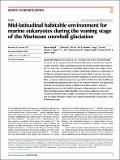Files in this item
Mid-latitudinal habitable environment for marine eukaryotes during the waning stage of the Marinoan snowball glaciation
Item metadata
| dc.contributor.author | Song, Huyue | |
| dc.contributor.author | An, Zhihui | |
| dc.contributor.author | Ye, Qin | |
| dc.contributor.author | Stüeken, Eva E. | |
| dc.contributor.author | Li, Jing | |
| dc.contributor.author | Hu, Jun | |
| dc.contributor.author | Algeo, Thomas J. | |
| dc.contributor.author | Tian, Li | |
| dc.contributor.author | Chu, Daoliang | |
| dc.contributor.author | Song, Haijun | |
| dc.contributor.author | Xiao, Shuhai | |
| dc.contributor.author | Tong, Jinnan | |
| dc.date.accessioned | 2023-04-06T15:30:04Z | |
| dc.date.available | 2023-04-06T15:30:04Z | |
| dc.date.issued | 2023-04-04 | |
| dc.identifier | 284013251 | |
| dc.identifier | 4887be3c-04fb-4e35-b3bf-3f939f3d04c5 | |
| dc.identifier | 85151855526 | |
| dc.identifier.citation | Song , H , An , Z , Ye , Q , Stüeken , E E , Li , J , Hu , J , Algeo , T J , Tian , L , Chu , D , Song , H , Xiao , S & Tong , J 2023 , ' Mid-latitudinal habitable environment for marine eukaryotes during the waning stage of the Marinoan snowball glaciation ' , Nature Communications , vol. 14 , 1564 . https://doi.org/10.1038/s41467-023-37172-x | en |
| dc.identifier.issn | 2041-1723 | |
| dc.identifier.other | Jisc: 1004216 | |
| dc.identifier.other | publisher-id: s41467-023-37172-x | |
| dc.identifier.other | manuscript: 37172 | |
| dc.identifier.other | ORCID: /0000-0001-6861-2490/work/132764492 | |
| dc.identifier.uri | https://hdl.handle.net/10023/27359 | |
| dc.description | Funding: This research was supported by the National Natural Science Foundation of China (42172032; 41872033) to H-Y.S., and the China Geological Survey (1212011120787, 12120114066301) to J.T. | en |
| dc.description.abstract | During the Marinoan Ice Age (ca. 654–635 Ma), one of the ‘Snowball Earth’ events in the Cryogenian Period, continental icesheets reached the tropical oceans. Oceanic refugia must have existed for aerobic marine eukaryotes to survive this event, as evidenced by benthic phototrophic macroalgae of the Songluo Biota preserved in black shales interbedded with glacial diamictites of the late Cryogenian Nantuo Formation in South China. However, the environmental conditions that allowed these organisms to thrive are poorly known. Here, we report carbon-nitrogen-iron geochemical data from the fossiliferous black shales and adjacent diamictites of the Nantuo Formation. Iron-speciation data document dysoxic-anoxic conditions in bottom waters, whereas nitrogen isotopes record aerobic nitrogen cycling perhaps in surface waters. These findings indicate that habitable open-ocean conditions were more extensive than previously thought, extending into mid-latitude coastal oceans and providing refugia for eukaryotic organisms during the waning stage of the Marinoan Ice Age. | |
| dc.format.extent | 9 | |
| dc.format.extent | 1513477 | |
| dc.language.iso | eng | |
| dc.relation.ispartof | Nature Communications | en |
| dc.subject | QE Geology | en |
| dc.subject | DAS | en |
| dc.subject | SDG 14 - Life Below Water | en |
| dc.subject | MCC | en |
| dc.subject.lcc | QE | en |
| dc.title | Mid-latitudinal habitable environment for marine eukaryotes during the waning stage of the Marinoan snowball glaciation | en |
| dc.type | Journal article | en |
| dc.contributor.institution | University of St Andrews. School of Earth & Environmental Sciences | en |
| dc.contributor.institution | University of St Andrews. St Andrews Centre for Exoplanet Science | en |
| dc.identifier.doi | 10.1038/s41467-023-37172-x | |
| dc.description.status | Peer reviewed | en |
This item appears in the following Collection(s)
Items in the St Andrews Research Repository are protected by copyright, with all rights reserved, unless otherwise indicated.

